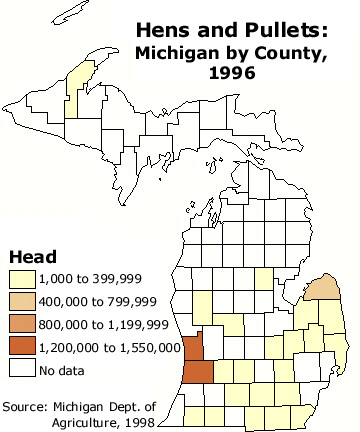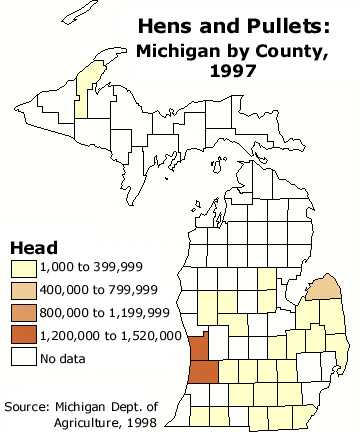CHICKENS AND POULTRY
North Carolina, Minnesota and California are among the top turkey producing states in the
United States. The Southeastern
states have the most egg and broiler (chicken) production.
A male chicken is called a rooster and a female chicken is a hen. Their offspring are
called chicks. Broilers are either male or female chickens that are raised for their meat.
They hatch in about three weeks from fertile eggs in hatcheries. They are fed until they
are six to seven weeks old and weigh four to five pounds. Then they are sold to market.
Some chickens, called roasters, are fed for 10-12 weeks and weigh eight to nine pounds
before they are ready for market.
Broilers and roasters are raised in large buildings called broiler houses. They have water
and feed such as corn, grain sorghum and soybeans available at all times.
Layers are hens which produce eggs for food. Eggs produced by layer hens (or layers) do
not contain an embryo. From hatching until five months of age, young layer chicks are
called pullets. Pullet farms raise chicks until they begin laying eggs, at about six
months of age; then they are called hens.
The total value of poultry production in Michigan during 1993 from
eggs, broilers, and other chickens (primarily culled layers) was over $55.5 million, 14%
more than a year earlier. Eggs contributed the largest share of value for all poultry. The
percentages of total poultry production value by commodity were: eggs 97%, other chickens
1%, and broilers 2%.
Michigan egg production in 1993 totaled 1.4 billion, unchanged from a
year earlier. The market egg price averaged 46 cents per dozen, 5.6 cents more than the
1992 price. Michigan ranked 16th in total egg production in 1993.
Broiler production was valued at $1,045,000 in 1993, 5% more than 1992.
This increase was due partly to a seven cent rise in the average price per pound.


Nationally, Michigan is not a major producer of poultry products, although in some counties a longstanding tradition of raising poultry still exists.
This material has been compiled for educational use only, and may not be reproduced without permission. One copy may be printed for personal use. Please contact Randall Schaetzl (soils@msu.edu) for more information or permissions.